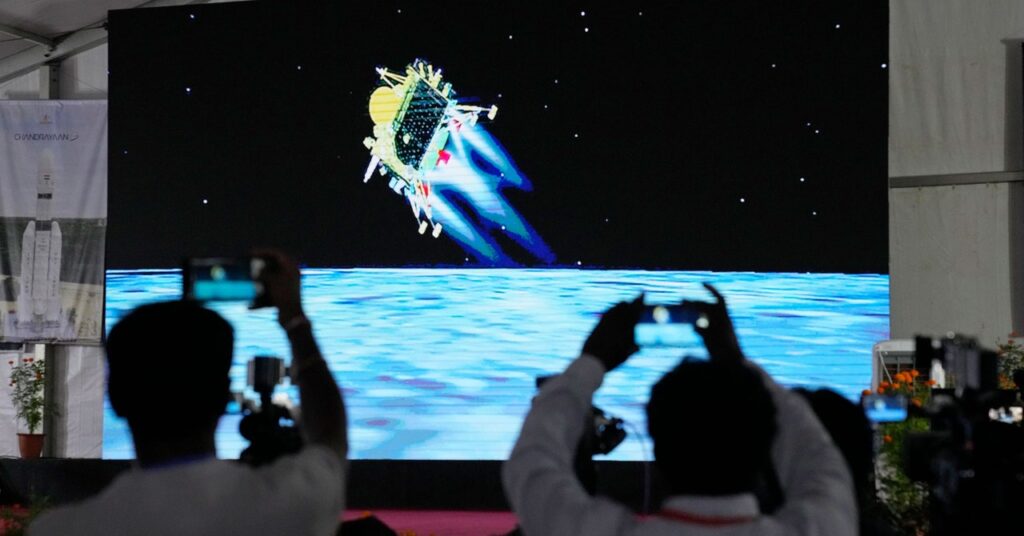[ad_1]
And nations should avoid cluttering those spots with mechanical detritus, which could complicate future missions. Like campers heading into the backcountry, it’s important to think carefully about what you pack with you and what you take out, Birk says.
India’s success doesn’t mean the end of the race toward the moon’s south pole, but it does boost India’s standing. “This will certainly contribute to its status as a rising power with technological prowess. What’s happening in space is a reflection of what’s happening geopolitically on Earth,” says Cassandra Steer, an expert on space law and space security at the Australian National University in Canberra. And while Roscosmos suffered a setback, this isn’t the end of their moon program either, or their role in the new lunar competition. The Soviets beat the US at every stage of the 20th-century space race, Steer says, except for the landing of astronauts on the moon. Next, Russia intends to collaborate with China on a lunar research station.
Over the past decade, only China’s space program has achieved considerable success landing spacecraft on the moon, including its Chang’e 3, 4, and 5 missions in 2013, 2019, and 2020. India’s Chandrayaan-2 and Israel’s Beresheet lander failed in 2019, and Japan’s Ispace lander failed this April.
In fact, until China made its first landing, the moon had arguably been neglected for decades. NASA ended its Apollo mission in 1972, and the USSR’s Luna-24 mission in 1976 was the last successful lunar landing. That could mean limited institutional memory, especially for Russia, making it tough to develop and deploy new moon missions, Metzger says.
Over the past few decades, Russia has been trying to resuscitate its program, but with little success. Roscosmos has Luna-26 and Luna-27 planned for 2027 and 2029, as the agency aims to bring an orbiter and a larger lander to the moon. But their limited funding, thanks to sanctions following the Ukraine invasion, means these followup missions will likely be delayed, Zak says. And if the space agency decides to overhaul their propulsion system design after investigating the failure of Luna-25, that could be another reason for delays, he adds.
NASA has fared better with its Artemis program, which last year sent the uncrewed Artemis 1 to orbit the moon and is aiming for a crewed landing in 2026. But the program has faced its own challenges: NASA plans on using a SpaceX Starship lander, though, as its abortive test flight in April shows, Starship clearly has a long way to go. More than half of the 10 cubesat satellites deployed by Artemis 1 experienced technical glitches or lost contact with Earth, including the Japanese Omotenashi probe, which was unable to land on the moon as planned.
NASA has increasingly relied on commercial partners in a bid to boost the speed and lower the price of moon exploration—moving some of the costs onto businesses, rather than taxpayers. But these companies, too, are new players in the space race. In late 2024, NASA plans to send its Viper rover on an Astrobotic lander, though that company’s first moon lander, meant to demonstrate the technology, hasn’t even launched yet. NASA has also charged Firefly Aerospace, Intuitive Machines, and Draper with delivering a variety of payloads to the lunar surface over the next couple years.
In the meantime, nations like India, Japan, and Israel have begun moon programs from scratch. India next plans to collaborate with Japan on the Lunar Polar Exploration rover, which would launch no sooner than 2026.
“We have set the bar now so high. Nothing less spectacular than this is going to be inspiring for any of us in the future,” said Shri M. Sankaran, director of ISRO’s U R Rao Satellite Centre, speaking on today’s telecast. “We will now be looking at putting a man in space, putting a spacecraft on Venus, and landing on Mars. Those efforts have been ongoing for years. This success today will inspire us and spur us to take those efforts even more strongly to make our country proud again and again and again.”
Updated 8/23/2023 12:00 pm ET: This story was updated to correct the ISRO chief’s name.
[ad_2]
Matéria ORIGINAL wired
